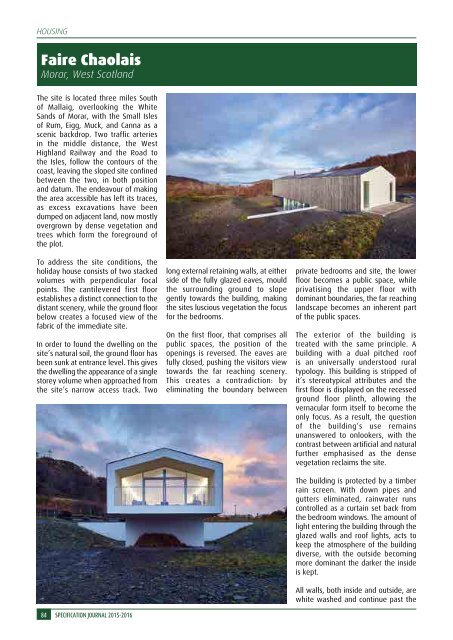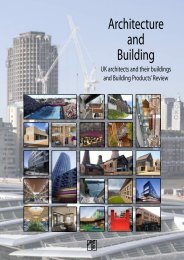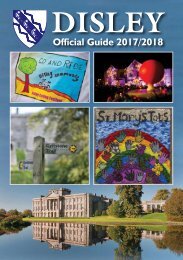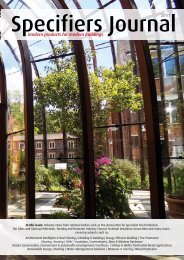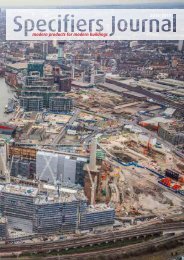Specifiers Journal 2015-2016
Specifiers Journal 2015-2016
Specifiers Journal 2015-2016
Create successful ePaper yourself
Turn your PDF publications into a flip-book with our unique Google optimized e-Paper software.
HOUSING<br />
Faire Chaolais<br />
Morar, West Scotland<br />
The site is located three miles South<br />
of Mallaig, overlooking the White<br />
Sands of Morar, with the Small Isles<br />
of Rum, Eigg, Muck, and Canna as a<br />
scenic backdrop. Two traffic arteries<br />
in the middle distance, the West<br />
Highland Railway and the Road to<br />
the Isles, follow the contours of the<br />
coast, leaving the sloped site confined<br />
between the two, in both position<br />
and datum. The endeavour of making<br />
the area accessible has left its traces,<br />
as excess excavations have been<br />
dumped on adjacent land, now mostly<br />
overgrown by dense vegetation and<br />
trees which form the foreground of<br />
the plot.<br />
To address the site conditions, the<br />
holiday house consists of two stacked<br />
volumes with perpendicular focal<br />
points. The cantilevered first floor<br />
establishes a distinct connection to the<br />
distant scenery, while the ground floor<br />
below creates a focused view of the<br />
fabric of the immediate site.<br />
In order to found the dwelling on the<br />
site’s natural soil, the ground floor has<br />
been sunk at entrance level. This gives<br />
the dwelling the appearance of a single<br />
storey volume when approached from<br />
the site’s narrow access track. Two<br />
84 SPECIFICATION JOURNAL <strong>2015</strong>-<strong>2016</strong><br />
long external retaining walls, at either<br />
side of the fully glazed eaves, mould<br />
the surrounding ground to slope<br />
gently towards the building, making<br />
the sites luscious vegetation the focus<br />
for the bedrooms.<br />
On the first floor, that comprises all<br />
public spaces, the position of the<br />
openings is reversed. The eaves are<br />
fully closed, pushing the visitors view<br />
towards the far reaching scenery.<br />
This creates a contradiction: by<br />
eliminating the boundary between<br />
private bedrooms and site, the lower<br />
floor becomes a public space, while<br />
privatising the upper floor with<br />
dominant boundaries, the far reaching<br />
landscape becomes an inherent part<br />
of the public spaces.<br />
The exterior of the building is<br />
treated with the same principle. A<br />
building with a dual pitched roof<br />
is an universally understood rural<br />
typology. This building is stripped of<br />
it’s stereotypical attributes and the<br />
first floor is displayed on the recessed<br />
ground floor plinth, allowing the<br />
vernacular form itself to become the<br />
only focus. As a result, the question<br />
of the building’s use remains<br />
unanswered to onlookers, with the<br />
contrast between artificial and natural<br />
further emphasised as the dense<br />
vegetation reclaims the site.<br />
The building is protected by a timber<br />
rain screen. With down pipes and<br />
gutters eliminated, rainwater runs<br />
controlled as a curtain set back from<br />
the bedroom windows. The amount of<br />
light entering the building through the<br />
glazed walls and roof lights, acts to<br />
keep the atmosphere of the building<br />
diverse, with the outside becoming<br />
more dominant the darker the inside<br />
is kept.<br />
All walls, both inside and outside, are<br />
white washed and continue past the


